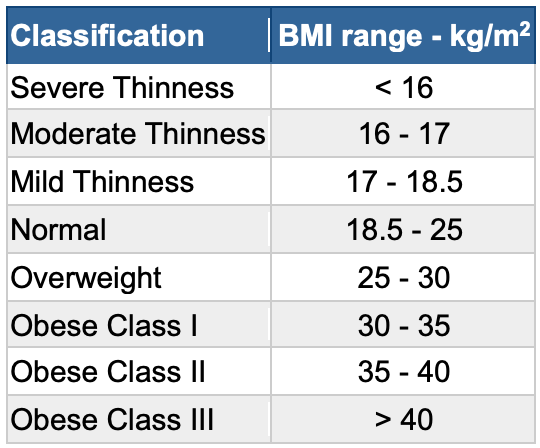What exactly is your Body Mass Index number telling you about your health?
BioBalance® Health uses other forms of measurement to determine body composition, and to diagnose healthy weight, versus overweight and obesity. BMI is a calculation of healthy weight, overweight, and obesity using just two parameters: Height and Weight. The US government endorses and uses this measurement in many ways to manage citizens, categorize them and even pay their salaries. The AMA has been using this as a measurement of body health for decades. As of July 2023, the AMA is rejecting this measurement of health and illness.
Calculate your BMI
Go to https://www.calculator.net/bmi-calculator.html and you can calculate your own BMI. Below is a chart that many types of companies and people use as a reliable measurement to use for many purposes. Below is the NIH explanation of BMI. You can find your BMI and corollate it with how lean your body is. The Body Mass Index (BMI) Calculator can be used to calculate BMI value and corresponding weight status while taking age into consideration. Use the “Metric Units” tab for the International System of Units or the “Other Units” tab to convert units into either US or metric units. Note that the calculator also computes the Ponderal Index in addition to BMI, both of which are discussed below in detail.
BMI introduction
BMI is a measurement of a person’s leanness or corpulence based on their height and weight and is intended to quantify tissue mass. It is widely used as a general indicator of whether a person has a healthy body weight for their height. Specifically, the value obtained from the calculation of BMI is used to categorize whether a person is underweight, normal weight, overweight, or obese depending on what range the value falls between. These ranges of BMI vary based on factors such as region and age and are sometimes further divided into subcategories such as severely underweight or very severely obese. Being overweight or underweight can have significant health effects, so while BMI is an imperfect measure of healthy body weight, it is a useful indicator of whether any additional testing or action is required. Refer to the table below to see the different categories based on BMI that are used by the calculator.
BMI table for adults
This is the World Health Organization’s (WHO) recommended body weight based on BMI values for adults. It is used for both men and women, age 20 or older.

BMI chart for adults
This is a graph of BMI categories based on the World Health Organization data. The dashed lines represent subdivisions within a major categorization.

BioBalance Doctors and Nurses have understood the fallacy of using BMI to judge whether a patient is overweight or not for decades, but the AMA and medical specialty societies have defended its use for as long as I have been in medical practice. However, BMI is a crude way to evaluate patients for obesity and we use a more accurate measure, a true body composition from an InBody® machine to determine exactly how much fat, muscle, and water our patients are made of and if they need to lose fat for their health. This true measurement of body composition gives us an accurate measurement of your percent body fat, weight of your muscle and your visceral fat (belly fat) measurement. You may say, “so what?”, but I’ll give you a few examples of how BMI is an INACCURATE measurement to follow for healthcare and for insurance, and other agencies that require employees to be a certain weight for their height.
In my practice I take care of two men whose height is exactly the same, 5-10 (70 inches), both weigh 200 lbs., and they both have a BMI of 28.69 which is considered overweight (normal is < 25). However, the two men are very different in their body compositions and therefore their health risks: Man number one has very little muscle and 30% body fat and is overweight and therefore is at risk for diseases that accompany obesity, high blood pressure, diabetes and heart disease. Man number two has a very muscular build with heavy bones and has a body fat of 19% and looks lean and is healthy and is not at risk for hypertension, heart disease and diabetes. The BMI makes them the same, and therefore their doctors and employers consider them the same for insurance, treatment of their illnesses and categorization in medical studies that determine the qualities that put patients at risk for diseases. Therefore, BMI is a very bad measurement to judge whether a person is at risk for diseases of obesity. The medical industry is big and slow, and this measurement will not be replaced with something else in the near future, however this gives you a basis for challenging the measurement as a basis for promotion, or a reason to deny you insurance or charge you more for insurance.
At Bio balance® Health we have used % body fat and abdominal visceral fat determined by a body composition machine (InBody) as our only measurements to determine future risk, and to determine whether someone requires weight loss treatment or not. BMI is very unfair to those people who are required to maintain a healthy weight for their jobs. Those men and women who are in the armed forces cannot be promoted in rank unless they have a BMI of 25 or less, however the training that is required and the strength and stamina to be in the active military means that they must work out and exercise to build muscle, which then disqualifies them from promotion because it causes them to gain weight, but healthy weight. Using the BMI as a measurement, can cause a person to be disqualified for promotion because they are well muscled!
Not only the US military discriminates against people with high BMI due to high percentage of muscle mass, the life insurance and health insurance industry does as well! A person is labeled obese and therefore “high risk” for illness and death just because they have a high percentage of muscle mass which is healthy, and not a risk. This makes some fit people uninsurable or increases what their life and health insurance costs.
The worst discrimination by BMI discriminates against genetically highly muscled groups of people. The BMI was created using white males and white females making them the standard, however some genetic groups from African, Hispanics, Italians and other groups of people from Mediterranean and middle eastern heritage are discriminated against because they have a higher percentage of muscle and bone mass normally, compared with Caucasians, eastern Indians, and Asians, therefore using the BMI causes these groups to look “fatter” when they are really more muscled with thicker bones, which is healthier, not a higher risk for illness.
Obviously, people with high muscle mass can still be obese, but it should not be determined by height and weight alone. This decision by the AMA has been a long time coming, and the number of people who have been harmed by this method of determining obesity is incalculable. BMI is just a measurement based on height and weight. For some average height and weight people, it is an accurate evaluation of normal body weight vs obesity. However, most people have various degrees of muscle mass, and it is the amount of muscle mass that skews the BMI measurement and judges some people as “obese” when they are at a healthy weight, and others are considered normal weight and composition even when they have a high body fat content and very little muscle.
AMA urges physicians to rethink use of BMI calculation
The American Medical Association voted this week to recommend that physicians not rely solely on body mass index as a way to evaluate whether a person is at a healthy weight, as there may be biases and inaccuracies inherent in the method. The AMA recommended that physicians also take into account visceral fat, body adiposity index, metabolic and genetic factors, and fat, bone and muscle percentage. Dr. Scott Hagan of the University of Washington termed BMI “a very poor measure of general health,” adding, “Someone with an elevated BMI may be perfectly healthy.” Full Story: The New York Times (6/15)
This Health cast was written and presented by Dr. Kathy Maupin, M.D., Bio-identical Hormone Replacement Expert and Author. www.BioBalanceHealth.com • (314) 993-0963. Please subscribe to our YouTube channel and please check “ Like “. Follow us on Facebook and Instagram at BioBalanceHealth.



